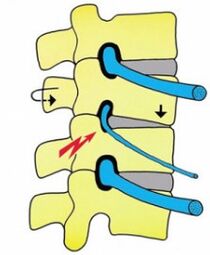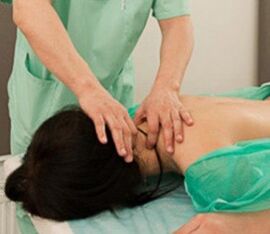Cervical osteochondrosis is a disease that is a dystrophic and degenerative disorder of the cervical discs of the spinal column. The cervical department is the most mobile, the muscle corset of this department in relation to others is much weaker. The neck performs the rotation and inclination of the head, therefore the spine in this area is subject to deformations, destruction, hernia and curvature formations.

The main causes of the disease
It has been established that osteochondosis is a disease that "becomes young". Now this disease is increasingly found among people aged 18 to 30, while previously cases of 40 were considered the norm. The reasons for this can be distinguished as follows:
- violation of posture, presence of spinal curvature based on the type of scoliosis, lordosis or cifosis;
- overweight, obesity;
- back injuries;
- Metabolic disorder, low metabolism;
- hard physical work;
- Hypodynamia, sedentary lifestyle;
- Weak physical training;
- nervous exhaustion, stress;
- non -compliance with training for hygiene in athletes;
- strong interruption of training;
- Infectious diseases;
- Hypothermia of the body.
Osteochondrosis, in essence, is a consequence of muscle terminals, muscle spasm in the end leads the mobility of the cervical column, interrupts blood circulation, worsens blood supply to bone and muscle tissues. As a result - Squeezed nerve roots and sensitivity loss.
Symptoms of cervical osteochondrosis
Cervical osteocondrosis has a variety of symptoms. However, for the most part, the manifestation of the osteocondrosis affects the circulatory system. In the cervical region there are many blood vessels that nourish the brain intensely. Therefore, the danger of osteochondrosis is associated with a scarce offer of head organs, in particular to the brain, blood. What the signs of osteochondosis of the cervical column will be expressed are influenced by the segment that has been defeated. Therefore, the following signs of cervical osteochondrosis are distinguished:
- roots syndromes;
- Cardinal syndrome;
- Irflex irritation syndromes;
- vertebral artery syndrome;
- Compression of the spinal cord.

What are the symptoms of cervical osteochondrosis in the event that rooser syndrome is characteristic? Rooser syndrome in medicine is called cervical roots, it occurs due to pizzichi of the nerve in the neck. The pain stands around the neck, go down to the scapula area, it can be lower on the shoulder and the forearm, to the fingers. The characteristic signs of cervical osteochondrosis in this case are the experience of tingling, burning senses, meal, numbness of the hands, forearms or fingers.
The symptoms of the osteocondrosis of the cervical region will have different, that the segment has decreased damage to the disease will influence their difference. In the event that the central nerve and its roots are interested, the pastose will be medium, index and the thumb. If the roots of the shoulder nerve have been affected, the pastose will be a finger and a finger of the ring finger. Osteochondrosis of the cervical column, the symptoms will have the following syndrome as irritation. The main feature will be the presence of acute, intense and burning pain in the cervical region and which consumes or in the neck itself. Pain tends to increase during movement or loads, it is particularly acute after a static state. For example, after sleep, with inaccurate turns of the head, after sleep. The cervical osteochondosis of the symptoms is similar, because with the development of this syndrome, the pain is transmitted to the chest. It is diagnosed in cases where the damage area is not limited to the neck, but goes to the chest segments. The symptoms show a wider spectrum of cervical osteochondrosis, the most main of them is a violation of the work of the internal organs.
The spinal artery syndrome - The exacerbation of the cervical osteocondrosis, the symptoms are shown in an extremely intensely way and consist in a serious and burning pain. The pain pulsating in the temples, the presence of serious migraines, which amaze in particular the parietal part, the back of the head and the in front region are characteristics. The pain is chronic, constant, but sometimes they record cases of paroxysmal pain. The exacerbation of the osteocondrosis of the cervical column expresses symptoms in the form of growing pain. This happens after being uncomfortable, with sudden movements, serious physical effort. The exacerbation threatens hearing disorders: a vestibular disorder, which experiences noise in the ears, as well as a decrease in hearing acuity. The vision problems are not rare. Osteochondrosis of the symptoms of the cervical light with cardinal syndrome. Cardinal syndrome is characterized by angina pectis grave. It makes it difficult to identify primary - osteochondrosis disease. The "osteochondosis of the cervical region" diagnostics is often carried out in a timely manner, while trying to diagnose angina pectis and treat it, this threatens the transition of osteochondrosis in chronic form.

The phenomenon of angina pectis is caused by tightening the spine in the lower segments of the cervical region, which finds a reflected response. Cardinal syndrome can manifest itself in cases where the roots of the chest or diaphragmatic nerve are irritated. The osteochondrosis of the symptoms of the cervical column with cardinal syndrome can occur in the form of tachycardia, extrasists. There are frequent cases in which osteochondosis of the cervical region and hypertension proceed jointly. In the same way, the symptoms of cervical osteochondrosis are symptoms, its treatment is not always expressed timely, since doctors initially diagnose cardiovascular diseases and not osteochondosis.
Symptoms and treatment of cervical osteocondrosis
A certain syndrome is diagnosed by the predominance of some symptoms, the treatment is already performed on the basis of this. The treatment is carried out in two ways: radical surgery, which implies or a conservative method. In these cases, if the conservative treatment has not given results, an indication for the operation is prescribed. The osteochondrosis of the cervical region is eliminated from the following methods:
- manual therapy;
- massages, physiotherapy procedures;
- reflexotherapy - acupuncture;
- medical care, pills;
- water procedures;
- Folk methods of treatment;
- LFK courses and wellness gymnastics.
Symptoms of cervical osteochondrosis treatment of tablet
Generally, pharmacological treatment is prescribed in cases where symptoms include the presence of severe pain. In fact, the pills are not a panacea for the cause of pain - osteochondrosis itself. The tablets are also prescribed if the temperature for the osteochondosis of the cervical column has increased. This symptom indicates the presence of inflammatory processes in the body, the inflammation of the tissues and nerves must be eliminated.

Cervical osteochondrosis, symptoms, treatment and gymnastics
An effective and convenient treatment method is considered a complex of operating therapy and gymnastics exercises. The exercises aim to increase the flexibility of the cervical column, increasing the distance between discus, strengthens the muscle corset that would protect the spine from injuries and damage. In addition, gymnastics and exercises establish the functioning of the circulatory system very effectively, this not only promotes bone tissue, but also allows us to normalize the blood flow in the brain. The main thing is to perform exercises under the supervision of a doctor.
Cervical osteochondrosis, symptoms and treatment of surgery
In the event that the conservative treatment has not given results, the operation is prescribed. It provides for the removal of processes, arches and ligaments, as well as the removal of hernias that fell into the vertebral column canal. After this procedure, the cases of the total instability of the cervical region are not rare. After surgery, a special support collar is prescribed to the patient, which stabilizes a weak neck and temporarily supports it.
As a rule, if the disease is diagnosed in a timely manner, the rigorous recommendations of the doctor is held and in a complete conservative therapy, osteochondrosis is significantly regulated, in many cases a frame of complete recovery is observed.


























